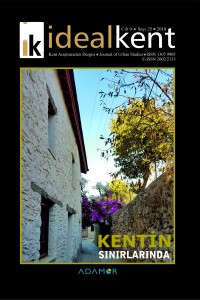Abstract
In
the city, it is increasingly encountered the spaces that are pushed out of the
free use of the citizens. This push out procedure – the force to abandon the
free use of urban space- also indicates that everyday life occupied by spaces
or spatial facilities controlled by state apparatuses. This situation can
considered as an attempt of power to create homogeneous, boring and sterile
spaces in the city. Power tends to create a sequence of spaces (not system) or
an urban environment (not pattern) where not only the physical control is
possible by the digital control mechanisms, but also isolated from diversity,
and the decreased depth of social interactions. In the place where the
follow-up mechanisms cannot operate, power tends to inhibit physical accessibility.
It is obvious that "heterotopic" spaces are in an extinguishing
process by power. In this context, could the concepts of
"Heterotopia" of Foucault and "Heterotopy" of Lefebvre
taken into the consideration to be able to revaluate/reread liberated and public
spaces of the city? Although these two concepts seem to describe the “space of
difference”, it is designated there are clear distinctions between them. This
article is an attempt to unfold the differentiation of the “space of
difference” within a holistic approach. This text is written to re-read the
spaces of difference and to recount the disappearing liberated side of urban
life.
References
- Althusser, L. (1994). İdeoloji ve devletin ideolojik aygıtları. (Y. Alp ve M. Özışık, Çev.) İstanbul: İletişim. (Orjinal eserin yayın tarihi: 1970).
- Foucault, M. (1997). Of other spaces: Utopias and heterotopias. N. Leach (Der.), Rethinking architecture- a reader in cultural theory içinde (ss: 329-357). Londra: Routledge.
- Harvey, D. (2013). Asi şehirler. (A. D. Temiz, Çev.) İstanbul: Metis. (Orjinal eserin yayın tarihi: 2012).
- Hetherington, K. (1997). Badlands of modernity- heterotopia and social ordering. Londra: Routledge.
- Lefebvre, H. (2003). The urban revolution. (R. Bononno, Çev.) Minesota & Lon-dra: University of Minesota Press. (Orjinal eserin yayın tarihi: 1970).
- Lefebvre, H. (2011). Kentsel devrim. (S. Sezer, Çev.). İstanbul: Sel. (Orjinal eserin yayın tarihi: 1970).
- Lefebvre, H. (2014). Mekanın üretimi. (I. Ergüden, Çev.). İstanbul: Sel. (Orjinal eserin yayın tarihi: 1974).
- McLeod, M. (1996). Everyday and ‘other’ spaces. D. Coleman, E. Panze ve C. Henderson (Der.), Architecture and feminism içinde (ss:1-37). New York: Princeton Architectural Press.
- Stavrides, S. (2016). Kentsel heterotopya. (A. Karatay, Çev.). İstanbul: Sel. (Orjinal eserin yayın tarihi: 2010).
- Stavrides, S. (2018). Müşterek mekan: Müşterekler olarak şehir. (C. Saraçoğlu, Çev.). İstanbul: Sel. (Orjinal eserin yayın tarihi: 2016).
Abstract
Kent içerisinde giderek
artan bir biçimde kentlinin özgür kullanımının dışına itilen mekanlarla
karşılaşılmaktadır. Bu itiliş -özgür kentsel kullanımın terkedilmeye
zorlanması- aynı zamanda iktidar aygıtlarının kontrol edebildiği mekanlar ya da
mekansal donatılar tarafından işgal edilmiş gündelik hayat anlamına
gelmektedir. Bu durum erkin, kent içinde bir tür türdeş, sıkıcı ve steril
mekanlar oluşturma girişimi olarak değerlendirilebilir. Erk, çeşitlilikten
yalıtılmış, sayısal kontrol mekanizmaları ile fiziksel takibin olası kılındığı
ve her türlü sosyal etkileşim derinliğinin azaltıldığı, bu mekanizmaların
işletilemediği durumda fiziksel erişimin engellendiği bir mekanlar dizisi
(dizge değil) ya da kent düzlemi (örüntü değil) oluşturma eğilimindedir. “Heterotopik”
mekanların, erk tarafından sönümlendirilmesi girişimiyle karşı karşıya
kalındığı aşikardır. Bu bağlamda, Foucault’nun “Heterotopia” ve Lefebvre’in
“Heterotopy” kavramları, kentin özgür ve kamusal alanlarını yeniden okuyabilmek
için elealınabilir mi? Farklılığın mekanını tarifleyen bu kavramlar sanki aynı
durumu tarifliyor gibi gözükseler de aralarında net ayrımların olduğu
belirlenmiştir. Bu makale farklılığın mekanının ayrımını bütüncül bir bakışla
ortaya çıkarma girişimidir. Bu metin, farklılığın mekanlarının yeniden
okunabilmesi ve kentsel yaşantının kaybolan özgür yanının yeniden görülmesi
gereğinin dillendirilmesi için yazılmıştır.
References
- Althusser, L. (1994). İdeoloji ve devletin ideolojik aygıtları. (Y. Alp ve M. Özışık, Çev.) İstanbul: İletişim. (Orjinal eserin yayın tarihi: 1970).
- Foucault, M. (1997). Of other spaces: Utopias and heterotopias. N. Leach (Der.), Rethinking architecture- a reader in cultural theory içinde (ss: 329-357). Londra: Routledge.
- Harvey, D. (2013). Asi şehirler. (A. D. Temiz, Çev.) İstanbul: Metis. (Orjinal eserin yayın tarihi: 2012).
- Hetherington, K. (1997). Badlands of modernity- heterotopia and social ordering. Londra: Routledge.
- Lefebvre, H. (2003). The urban revolution. (R. Bononno, Çev.) Minesota & Lon-dra: University of Minesota Press. (Orjinal eserin yayın tarihi: 1970).
- Lefebvre, H. (2011). Kentsel devrim. (S. Sezer, Çev.). İstanbul: Sel. (Orjinal eserin yayın tarihi: 1970).
- Lefebvre, H. (2014). Mekanın üretimi. (I. Ergüden, Çev.). İstanbul: Sel. (Orjinal eserin yayın tarihi: 1974).
- McLeod, M. (1996). Everyday and ‘other’ spaces. D. Coleman, E. Panze ve C. Henderson (Der.), Architecture and feminism içinde (ss:1-37). New York: Princeton Architectural Press.
- Stavrides, S. (2016). Kentsel heterotopya. (A. Karatay, Çev.). İstanbul: Sel. (Orjinal eserin yayın tarihi: 2010).
- Stavrides, S. (2018). Müşterek mekan: Müşterekler olarak şehir. (C. Saraçoğlu, Çev.). İstanbul: Sel. (Orjinal eserin yayın tarihi: 2016).
Details
| Primary Language | Turkish |
|---|---|
| Journal Section | Research Article |
| Authors | |
| Publication Date | December 30, 2018 |
| Published in Issue | Year 2018 Volume: 9 Issue: 25 |

